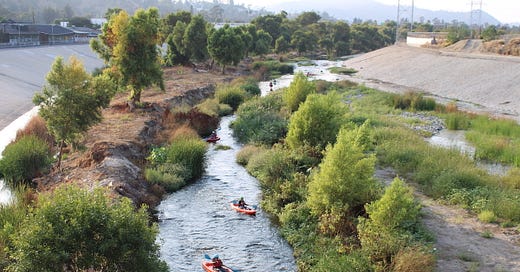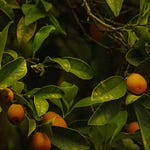LA's Water Crisis and the Road to Resilience 💧🌱
Hey LA Climate Fam! 🌞
Today we want to talk about the water crisis in Los Angeles and the actions local leaders are taking to fix it. Now, it goes without saying (but I’m going to say it anyway) that nothing is more important to life than our H2O. Did you know you can survive for three weeks without food but only three days without water? Enough said.
So the problem in Los Angeles is that we simply can’t rely on where we’re getting our water from anymore. No need to fret, though, cause LA’s making moves to implement big-time solutions.
Here’s the scoop on where our water comes from, the challenges we face, and the solutions underway. Ready for a quick dive? Here we go.
Around 85-90% of LA city’s water is imported from far-off sources. That means millions of people currently depend on water that’s not locally available.
Anyway, this imported water takes a long commute via three aqueducts to reach us:
There’s the California State Water Aqueduct, which delivers around 30% of LA’s water from the Northern Sierra Nevada.
Then we’ve got The Colorado River Aqueduct. This thing supplies around 25% of our water and brings it to us from over 1,400 miles away.
Finally, we get the rest of our imported water from Owen’s Valley in the Eastern Sierras through the iconic Los Angeles Aqueduct. Built over a century ago, wars were fought cause of this aqueduct (and the stolen water it carried).
LA simply would not be LA if we didn’t import all this water from elsewhere. But these sources are drying up thanks to prolonged droughts (AKA climate change). Plus, hauling over all that water is a costly, energy-intensive process that leaves a hefty carbon footprint. Sounds like a lose-lose situation to me. Now, LA is looking to its local water supplies to meet future demands.
Believe it or not, LA has plenty of water flowing right underneath our feet and through our rivers and it can meet all of our needs. But right now, local water sources make up only 10-15% of our water supply. Clearly, our local water game needs a serious makeover.
Here’s a look at what we’ve got:
Groundwater: Beneath LA, there’s a vast network of aquifers that could supply tons of water. As of now, this is our main local water source. Years of industrial pollution and urban runoff have contaminated our groundwater with harmful chemicals and heavy metals.
Surface Water: LA’s rivers, like the Los Angeles River and San Gabriel River, were once essential to the city’s water supply. Sadly, now, they’re also pretty polluted, also from urban runoff and contaminated stormwater.
Recycled Water: Water from our sinks, showers, and toilets gets a second life at treatment plants, where it’s cleaned and reused. Some people think it’s funny to say “toilet-to-tap” water, but let’s shun this poor marketing slogan for now. The big point is that we need to be doing a lot more water recycling.
Stormwater: Every time it rains, millions of gallons of water run off our streets, carrying a toxic soup of trash and pollutants into storm drains before spilling into our ocean. But you know what the real problem is? LA is a concrete jungle with a tragic lack of spongy permeable spaces that can capture stormwater. So instead of the water being absorbed, treated, and reused, it just gets wasted.
If this made you feel a little upset, or depressed, I totally get it, but now that we’ve heard about the problems, it’s time to dive into the solutions. Spoiler alert—there’s plenty of hope on the horizon!
LA has bold, well-thought-out plans to solve our water troubles. Thanks to Measure W, which LA County voters passed back in 2018, there’s mucho dinero to fund the County’s Safe Clean Water Program.
The main objectives are to significantly level up our water recycling game, clean up our polluted groundwater, and capture way more stormwater.
While these goals lay a solid foundation for water resilience, local water advocacy groups believe we need to be more ambitious to achieve them. That’s why LA Waterkeeper, the Natural Resources Defense Council, and Heal the Bay, recently presented Vision 2045, a report calling for LA County to take bolder, faster action. Here’s 5 of the big milestones that the Vision 2045 proposal aims to help LA reach:
Source 80% of LA’s water locally in the next 20 years. 💧
Cut water pollution by 50% within the next 5 years.
Ensure 10% of sustainability projects are led by underserved communities.
Create 12,000 acres of new green spaces by 2045 to capture stormwater.
Honor the Indigenous stewardship of the Tongva, Tataviam, Kizh, and Chumash Peoples.
Now, while these plans all sound promising, there’s really no certainty that the target goals will be met. That’s why we need organizations like our partners, LA Waterkeeper and FoLAR, who, along with Heal the Bay, have been key players in improving LA’s water systems for over three decades. Let’s learn a little bit more about them.
LA Waterkeeper is fighting to protect LA’s waters using the law, science, and community action.
Friends of the LA River (aka FoLAR) is building a vibrant river ecosystem that reduces flood risk, supports biodiversity, and provides equitable access to nature.
Heal the Bay is dedicated to making the coastal waters and watersheds in Greater Los Angeles safe, healthy, and clean.
So, that just about wraps up our water adventure. Moral of the story: all Angelenos deserve access to clean, reliable water sourced locally. Most of our water will have to come from aquifers, stormwater capture, and recycling. That’s why we need to support and get involved with LA’s water heroes because they’re the ones fighting to make this happen. It’s gonna take a lot of work and grit to ensure that every drop of water counts, but together, we’ve got this! 🚀🌊








Share this post